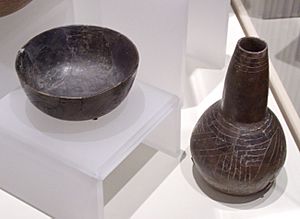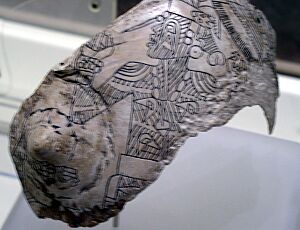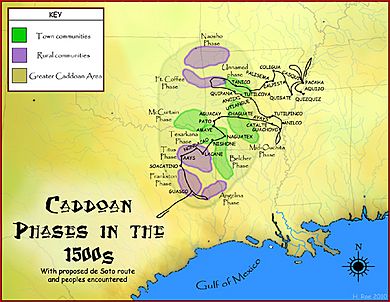Caddoan Mississippian culture facts for kids
The Caddoan Mississippian culture was an ancient Native American culture. Archaeologists consider it a type of the larger Mississippian culture. The Caddoan Mississippians lived in a large area. This area included parts of what is now Eastern Oklahoma, Western Arkansas, Northeast Texas, and Northwest Louisiana in the United States.
Experts believe that the Caddoan culture has continued from ancient times to today. The people who spoke Caddo and other Caddoan languages long ago are the direct ancestors of the modern Caddo Nation of Oklahoma.
Contents
About the Caddoan Mississippians
How Their Culture Grew
The Caddoan Mississippians likely came from earlier groups. These groups lived in the area between 200 BCE and 800 CE. They were connected to other people across the Eastern Woodlands through large trade networks. During this time, they learned how to make pottery. They also got the bow and arrow from people to their Southwest.
Around 800 CE, early Caddoan society began to form. It became one of the first Mississippian cultures. Some villages grew into important centers for ceremonies. People worked together to build large earth mounds. These mounds were often used for temples or homes for important leaders. The mounds were built around big, open, flat areas called plazas. These plazas were kept clean and used for special events with many people.
As their society grew, some families became more important than others. We know this from large tombs found by archaeologists. These tombs contained special items that showed power and importance.
By 1000 CE, the society we now call "Caddoan" had fully developed. Important centers became even more prominent. Some family groups had more control over their communities. The tombs of leaders had many valuable items. Sometimes, other people were buried with these leaders, too.
Major sites like Spiro and the Battle Mound Site were built. They were located in the Arkansas River Valley and the Red River Valley. These areas had the most fertile land in the Caddoan region. They could grow a lot of maize (corn). This extra food helped large populations grow in these main centers. By 1200 CE, Caddoan people were growing a lot of maize in their many villages and farms.
The Caddoans also made a special type of pottery. In 1540, members of the Hernando de Soto expedition said it was some of the best they had ever seen.
Recent digs have shown that there was more cultural variety in the Caddoan region than once thought. This was especially true for sites along the Arkansas River. Caddoan Mississippian towns had a less organized layout of mounds and villages. Towns in the main Mississippian area to the East, along the Ohio and Mississippi rivers, were often more structured. Caddoan towns also did not have wooden walls called palisades for defense. These were common in major Middle Mississippian towns.
The Caddoans lived on the western edge of the Mississippian world. They might have faced fewer threats from other groups. Their societies might also have had less strict social classes. The climate to the west was drier, which made it harder to grow maize. This meant fewer people lived on the plains to the West. So, the Caddoans did not have to compete with many neighboring groups.
However, Caddoan populations reached their highest point around 1400 CE. After this, many important centers became less populated. People started living more spread out, on scattered farms instead of in large villages. The cultural unity of the area also began to break down. Many different local cultures started to appear.
Trade Networks
Caddoan Mississippian people traded with the larger Mississippian world to the East. They also traded with other cultures to the Southwest. Their trade networks covered much of North America.
Archaeologists found many items at the Spiro site. These included colored flint from New Mexico, copper from the Great Lakes area, and conch shells from the Gulf Coast. They also found mica from the Carolinas. Other trade goods included wood, baskets, woven cloth, fur, feathers, and carved stone statues.
Some items came from far away places like Cahokia in Illinois, Etowah and Ocmulgee in Georgia, and Moundville in Alabama. Many of these items had symbols from the Southeastern Ceremonial Complex. This was a large trade and religious network that connected many different groups.
The Spiro site is the only Mississippian site where an item from Mesoamerica has been found. This was a piece of black obsidian from Mexico. It likely reached Spiro through trade between the Caddoan Mississippians and people to the Southwest. Using these valuable materials, Caddoan artists made beautiful art. This art showed their cultural identity and their spiritual beliefs.
Languages Spoken
The Caddoan Mississippians spoke many Caddoan languages. These languages were once spoken over a wide area. Today, many of them are no longer spoken. The modern languages in the Caddoan family include Caddo and Pawnee. These were spoken by historic tribes in the area. Now, mostly tribal elders speak them.
Important Sites
| Site | Image | Description |
|---|---|---|
| Battle Mound Site | Located in Lafayette County, Arkansas. It has the largest mound of the Caddoan Mississippian culture. | |
| Caddoan Mounds State Historic Site | Also known as the George C. Davis Site (41CE19). It is in Cherokee County, Texas, in the Piney Woods region. | |
| Spiro Mounds |  |
One of the most studied archaeological centers of Mississippian culture. It is in Eastern Oklahoma near the town of Spiro. |
Contact with Europeans
When the Spanish conquistador Hernando de Soto explored North America in the 1540s, his group met several Native American groups. These groups were called the Naguatex, Nishone, Hacanac, and Nondacao. Today, we believe these names referred to Caddo villages.
In 1520, it is thought that about 250,000 Caddoan-speaking people lived in the area. Over the next 250 years, their population greatly decreased. This was mainly due to diseases brought by Spanish and French colonists. These diseases spread through Native American trade networks. After Europeans arrived, the Caddo organized into three main groups: the Natchitoches, Hasinai, and Kadohadacho. All Caddoan people were connected by a common language.
In the early 1800s, the United States passed the Indian Removal Act. This law forced the Caddo to give up their lands and move to Indian Territory. European Americans wanted to settle in the fertile river valleys where the Caddo lived. Later, the Caddo were required to divide their shared lands into individual plots. This happened before Oklahoma became a state in 1907.
The Caddo Today
The Caddo Nation of Oklahoma is a federally recognized tribe. This means the U.S. government officially recognizes them. They reorganized and set up their own government in the 20th century. They have an elected tribal council with eight members and a chairperson.
The tribe is based in Binger, Oklahoma. Their tribal complex, dance grounds, and the Caddo Heritage Museum are located south of Binger. In 2008, about 5,000 people were part of the tribe. About 2,500 of them lived in Oklahoma. The tribe runs its own housing programs and issues its own vehicle tags. They also have administrative centers, community centers, and an active office for Native American Graves Protection and Repatriation Act (NAGPRA).
The Caddo have started several programs to keep their traditions strong. The tribe holds a summer culture camp for children. Groups like the Hasinai Society and Caddo Culture Club help keep Caddo songs and dances alive. The Kiwat Hasinay Foundation works to preserve the Caddo language.




